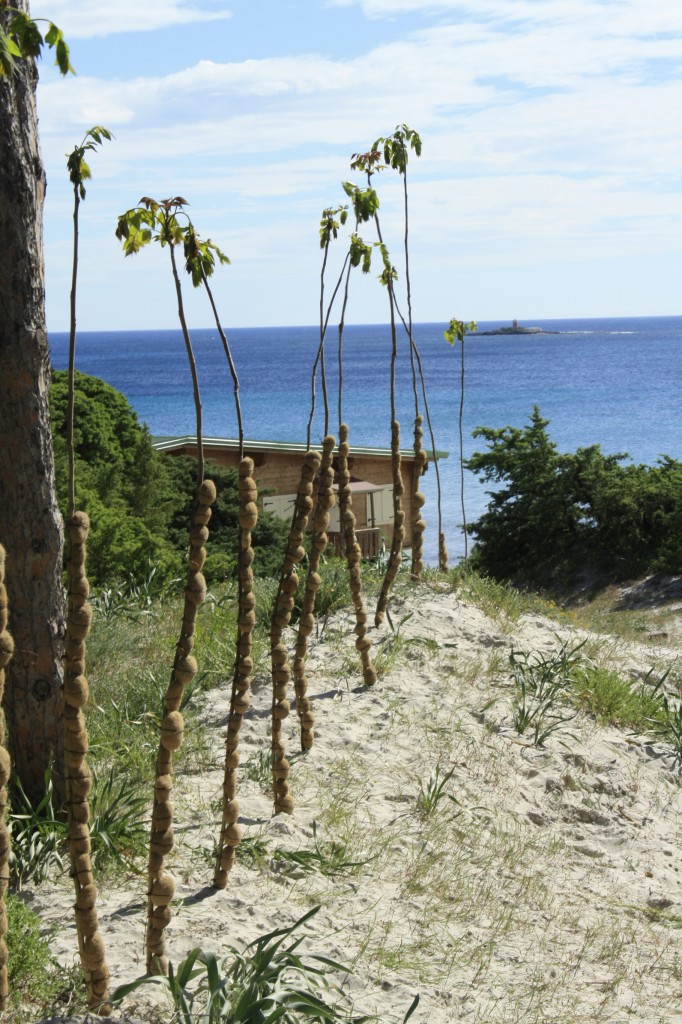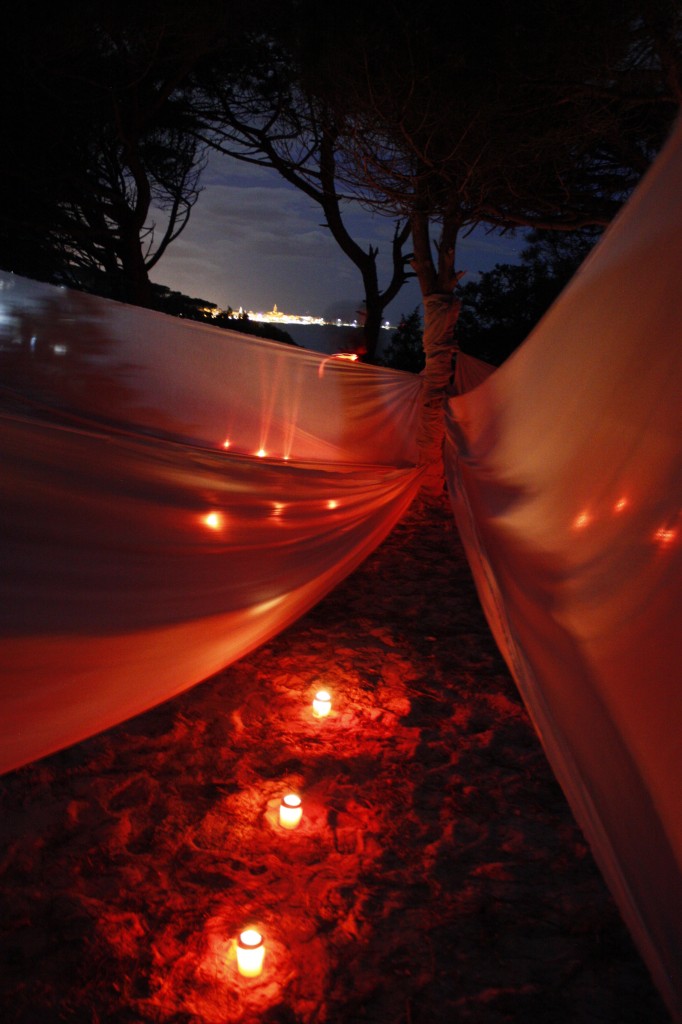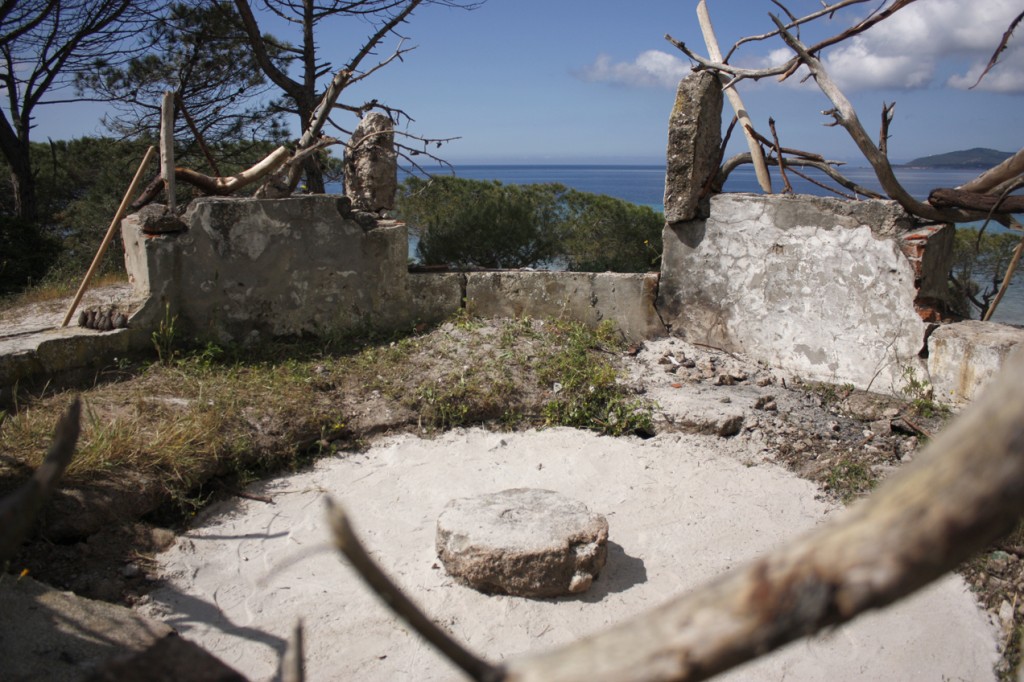A guest post by landscape architect Lucy Thayer
On April 22, 2010 the Architecture Theory class went to Alghero, Sardinia for four days to create installations in the sand dunes. Our class had spent the last several weeks preparing for the trip, thinking of concepts and strategies. None of us knew what to expect of our four groups with their four unique approaches to the challenge.
Late Thursday night, as we groggily emerged from the tiny coastal airport of Alghero, we all noticed the fresh and pleasant island air. Our flat, a bed and breakfast by the ocean, soon found us happily dreaming in our beds. The site of our installation was the nearby beach and the surrounding dunes. That Friday morning happened to be drizzly, (which eventually turned to hard rain in the afternoon) but it was still pleasant to walk around the site and peruse the beach area.
At the beach we met with a class from the University of Alghero who had done this same exercise the previous year. The students brought us to their sites, most of which were remains and memories at this point, and discussed their work. This review of previous work was helpful for us, as we had all arrived with a concept and idea we hoped to execute, but no specific knowledge of how we would meld the ideas we formulated in Rome to the actual site in Alghero. Before lunch we had a couple of hours to explore and figure that out.
We walked to the center of Alghero for lunch. Our professor brought us to a little restaurant frequented by the university staff and students. It was delicious and reasonably priced! Most of the plates at my table were of pasta – colored black by squid ink with mussels- it was the best black pasta I have ever eaten! After lunch, we took a short tour of the center, specifically looking at the historic wall of Alghero that bordered the shoreline. Along the way, we saw the house of the parents of the future wife of George Clooney, so it was quite the well-rounded tour. The rest of the afternoon, each group spent time planning execution of their project, tests or trials, until it really started to rain, so we called it a day.
Saturday morning was warm and cloudy and with ideas ready, we headed to the beach and started working. The sun came out during our short lunch break, and many beach-goers mysteriously showed up too. It was nice to be in the sun, but we didn’t relax, as we were all eager to finish our installations and see the final product. We worked all day and each group finished at different times, but we had it all completed by the end of the day. My group celebrated by walking home on the beach during the sunset and going back to the restaurant for more black pasta.
We were all hoping for a sunny and warm Sunday, and it was everything we might imagine a Sunday in Sardinia could be. We headed to the beach to check our installations and make adjustments as necessary. Only 30 minutes behind schedule, at about 12:30, we began a tour of all the installation sites with guests who had come to see our work. We were supposed to start at 12:00, but, hey, it’s Italy and that was a timely start; no one (especially not me) complained about waiting on the beach! Visiting the sites was great – wow- each group’s installation was truly great.
It was a pleasure to see and hear the explanations of everyone’s work because we had all been so busy finishing our own projects that we didn’t have time to take in each others’ work. We finished the tour a little before 2:00 and headed to lunch at the ‘hut’ that is a snack bar during the tourist season. Locals, who stay there all year, let us use their facilities to keep our tools in, etc. It was here the locals prepared our lunch.
They served traditional Sardi fare for us, beginning with a wheel of fresh pecorino cheese and bread, then gnocchetti with a tomato and lamb sauce, and ending with lamb and artichokes, which had been cut fresh that morning. The food was deliciously memorable. We had an extra bit of time to enjoy the beach before it was time to head back to Rome, given that the locals generously gave us a ride to the airport, and we didn’t have to take the bus! Italian hospitality seemed unending.
We will remember the experiences we had on the beach of Alghero, Sardinia even though before we knew it the weekend was over…the challenges prepared, executed, and delivered with imagination. On our way back to Rome we were tired and satisfied that this had been a great project for students, good to review and to remember.
Below are project descriptions and images from each group in the course:
FORAS LOCI
Carina Steinhoff, Lucy Thayer
‘Invasive species’ are found, blamed and despised all over the world. Ailanthus altissima, considered a nuisance plant, thrives along Alghero’s roadsides and ditches. Posidonia oceanica washes up on shore by the hundreds, peppering the beach with dry brown balls.
The effort exerted to remove and control these plants is extensive. The project highlights these invasive species, taking them out of context and looking at them in a different way.
This was accomplished at the top of the sand dunes, a place where neither Ailanthus nor Posidonia is found. Present, however, as collector and transplanter of both species was the most effective invader of all – man. The two plants were united with Juniper roots exposed by erosion along the beach. Planted in a line, the Ailanthus flowed over the topography of the dunes, while the Posidonia acted as the datum, marking the rise and fall from one dune to the next. Both invaders move through the dunes and lead to the ocean.
Together these forces cause one to ask – what is an invasive species? what does it effect? who is responsible?
LABRYINTH
Asha Isaacs, Fay Zhou
During the semester we have seen numerous garden and landscape designs. We realized most of these landscape designs look natural in their present form but are a man made creation. We decided to use as much of the natural surrounding resources while still allowing the viewer to realize the structure was a creation for this particular site.
We chose to construct the installation out of fabric, tree trunks, string and candles. The way the fabric was secured to each tree branch determined a view of the ocean, forest and cityscape. The transparent fabric was layered spreading out from a central point which was a planted tree branch. The initial concept to create a grid like structure manifested itself into a separate project which was seen on entering the site. For this smaller instillation we gathered tree branches found on the beach to create the grid in the sand. Both installations created incorporate as much of the natural surroundings as possible and we planned to create an instillation that could be left on site.
The inspiration for the project comes from the notion of taking in ones surroundings to create something new, specific to a place and time. We were inspired by Maria Lai,Christo and Jeanne-Claude The Gates in Central Park, Running Fence, The Umbrellas, Valley Curtain Robert Smithson Spiral Jetty, The Lighting and his use of the earth Dennis Oppenheim.
We took into account the skyline of Alghero and the necessity for people to be able to physically walk through our installation. The tree trunks were connected by the white transparent fabric, which was inspired by the famous Alghero artist Maris Lai. She was able to connect the whole city of Alghero with a thread. We used the fabric as a tool to create new lines of sight, this was inspired by Easter in Alghero: street lamps along the ancient fortress walls are covered with red fabric. We hoped to touch on this theme by placing red candles in between the fabric. The candles light during the night instillation reflected their glow below while the cityscape lights shown from above.
First we decided on which location would best fit our needs for the installation. We chose a site that had a level surface but was raised above on a dune in order to see different views of the forest, cityscape and ocean. Once we decided on this site we took to planting trees. The main point from which the fabric would come from was a tree that was planted in the center of the open space. From here we used string to determine the height of each piece of fabric. We used the string tied between trees to dictate what views we wanted to create. Once the string grid was set we then replaced the string with fabric.
DATUM
Juliette Dubroca, Lisa Nesterova, Phoebe White
Once in the dunes of Alghero, we noticed that the local environment was rapidly transforming: the dunes were eroding and the construction of the two recent harbors affected the immediate shoreline. With this idea of landscape transformation in mind, we decided to create an installation that would document the changes in the three different environments of our site. Our installation was a strip composed of two hundred plastic cups submerged into the ground. This strip was divided into three different site conditions: sea to dune, dune to meadow and meadow to forest. Over twenty four hours, our data collectors showed us samples of significant changes in the landscape conditions. The two areas that demonstrated the most change were the sea to dune and dune to meadow sections. In the short period of data collecting, erosion of the dune was noted.
We hoped that the installation would intrigue the visitors of the beach. By examining the data collectors in the three different sections of the site, the viewers would become aware of the constant environmental and landscape changes.
SOMETHING ABOUT CONTAINERS . . .
Alan McNutt
On wandering the site, I found there to be many lines of travel that traversed the distinct thresholds of the Maria Pia Pinewood. Fragmentary moments broke the transformed animal paths, opening to clearings of sky or ending in bed baskets of juniper and cypress. Life was moving, and beautiful. Yet, I found death was everywhere. Not the violent kind of death of war-stained cities, just the old and forgotten kind that you sometimes find in the dark windows of Rome. Naked and gnarled trees of grey swept to the charred and lost objects that litter the rolling landscape. Things once inhabited and useful now lay empty and void of life. Containers became an object of my interest.
Water, the essence of life, is held in containers. The soft-bodied creatures of the sea create and trade their containers. The habits and comforts of human activity occur too, within containers.
Two forms called my attention. One rigid, and rectilinear. The other dynamic, and circular. Both ruins of a WWII effort to hold the Western coast of Alghero. The square is the geometry of our realm, that of the earth. The circle, that of the sky and heavens beyond. I took two moves in my work here, first, carving deeper into the imbedded boxes of earth and matter, and second, spiraling up in a skyward reach of light and air.
There’s something about containers…




